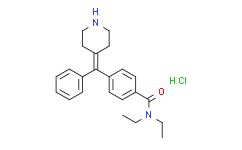| Description: |
AR-M 1000390 hydrochloride is an exceptionally selective, potent δ opioid receptor agonist with an EC50 of 7.2±0.9 nM for δ agonist potency. |
| Target: |
EC50: 7.2±0.9 nM (δ opioid receptor)[1] |
| In Vivo: |
Rats are treated with 5, 100, and 600 μmol/kg of AR-M 1000390 (AR-M100390) for 3 and/or 7 days; another group of rats treated with 600 μmol/kg of compound are allowed to recover for 14 days. AR-M 1000390 (600 μmol/kg) causes vacuolation in the β-cell of the rat pancreas that is associated with depletion of insulin and hyperglycemia after 7 days of dosing. Treatment of rats with 600 μmol/kg of AR-M 1000390 results in vacuolation of the β-cell of the rat pancreas that is similar to that reported for cyclizine and cyproheptadine[2]. |
| In Vitro: |
EC50: 7.2±0.9 nM (δ opioid receptor)[1] |
| Cell Assay: |
RINm5F cells are seeded in 24-well plates and treated with vehicle (DMSO), 10 μM AR-M 1000390 (AR-M100390), and 10 μM Cyclizine in serum-free medium; cells are rinsed with phosphate-buffered saline and stored at -80°C until analysis. RNA is isolated with the RNeasy purification system with DNAse treatment[2]. |
| Animal Administration: |
Rats[2] Han Wistar rats (six per treatment group) are treated with vehicle (saline) or 5, 100, and 600 μmol/kg/day of AR-M 1000390 (AR-M100390) for 7 days. A separate group of rats are treated with 600 μmol/kg/day for 7 days followed by a 14-day recovery period. Another group is treated with 600 μmol/kg/day for 3 days. Blood sampling for glucose, lipids, and insulin measurements are taken on days 2, 4, 8, and 22. Blood sampling for AR-M 1000390 concentration measurements are collected on days 4 and 8. The animals are euthanized with CO2 on days 4, 8, and 22 and the pancreas isolated and processed for histopathology, insulin immunohistochemistry, and insulin mRNA analyses[2]. |
| References: |
[1]. Wei ZY, et al. N,N-Diethyl-4-(phenylpiperidin-4-ylidenemethyl)benzamide: a novel, exceptionally selective, potent delta opioid receptor agonist with oral bioavailability and its analogues. J Med Chem. 2000 Oct 19;43(21):3895-905.
[2]. Otieno MA, et al. Mechanistic investigation of N,N-diethyl-4-(phenyl-piperidin-4-ylidenemethyl)-benzamide-inducedinsulin depletion in the rat and RINm5F cells. Toxicol Sci. 2008 Sep;105(1):221-9. |






















